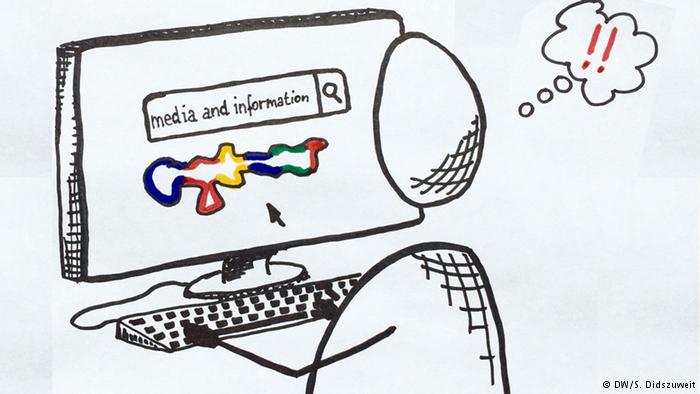“Everywhere, people are yearning to freely express themselves, to actively participate in governance processes and cultural exchanges. Media and Information Literacy (MIL) is a basis for enhancing access to information and knowledge, freedom of expression, and quality education.” Jānis Kārkliņš, former Assistant Director-General for Communication and Information of UNESCO
MIL Week objectives: – Increase Media and Information Literacy (MIL) awareness around the world; – Promote diversity, pluralism, intercultural dialogue and equality; – Promote international cooperation on MIL; – Create a constructive spaces for knowledge sharing, research and debate; and – Launch new projects
Plan of action: connecting a large number of actors to support MIL and to foster intercultural dialogue. 10 ways to celebrate MIL Week is an innovative way for everyone to participate in improving MIL awareness globally and to advocate for national policies. It is one way to stimulate the Global Alliance for Partnerships on MIL (GAPMIL) and promote related actions globally – reaching those who cannot participate to the physical conference.
- Organize a MIL Day
Organize a MIL Day in your community by bringing together diverse actors committed to MIL (NGOS, MIL practitioners, local media, policy makers, students, teachers etc.). Many local MIL Days will make an echo from the conference.
- Mainstreaming MIL topic at universities
Relevant education/training institutions are invited to organize special debates, lectures, or colloquium to promote MIL around the globe.
Communication, information and library science, and education departments can disseminate research findings on themes related to media and information literacy and intercultural dialogue.
- Use social media to raise awareness about MIL in civil society
A good way to promote media and information literacy is to use media and technology as vehicles for this purpose. Use social media to promote MIL globally. Use the hashtag #MILWeek and share your experiences with the world!
You don’t know what the MIL is? If you are able to use a social network service, such as Facebook, twitter, google+, etc., then you already have some media and information literacy skills. But are you using it effectively? Do you know how to critically analyse information and media content online and offline?
If you are between ages 15 and 25 and want to know more about MIL, click here to register for online course.
Share these videos with your friends: https://youtu.be/DhZaFsehZp4; https://youtu.be/lhQQEUBLdRc; https://youtu.be/NwYoPx_PYC0; https://youtu.be/yGHe02TlZQ8;
Make citizens aware of the benefits of MIL competencies to their daily lives. Making people more aware about MIL themes is more likely to draw policy maker’s attention.
- Send a letter
Send a letter to your local media, library, Internet service provider etc. requesting that they do more to promote MIL in your community.
- Give a voice to the youth
Youth are major users of information, media and new communication technologies. It is more important than ever to support the new generation to use them effectively. Youth speaking to youth and youth speaking to adults are powerful ways to empower them to be active promoters of MIL. Encourage youth to make their voice heard.
Youth organizations can organize short webinars and discussions/debates within their youth networks. Encourage youth to blog about media and information literacy and intercultural dialogue.
Media, journalists and libraries, both on or off line can engage youth through interviews, community outreach activities, to voice their opinion on MIL and intercultural dialogue.
- Join the Global Alliance for Media and Information Literacy (GAPMIL)
Promote MIL at a global scale by joining the Global Alliance. Click here to complete a brief survey. This is a pledge to commitment to dialogue. By joining GAPMIL, you will participate to global work with common goals.
- Create new partnerships, locally or regionally, to promote MIL in society
Connect with other partners nationally and regionally. Explore the setting up of national or regional MIL associations/networks were these do not exist – connect these to GAPMIL.
- Promoting UNESCO’s publications and actions
You can download, exhibit, distribute or tweet links for publications produced or supported by UNESCO and other partners: – Media and information Literacy Curriculum for Teachers – Media and Information Literacy Policy and Strategy Guidelines – Global Framework on MIL Indicators – Guidelines for Broadcasters on Promoting User-Generated Content and MIL – Mapping media education policies in the world: visions, programmes and challenges – Overview of Information Literacy Resources Worldwide – Empowerment through Media Education. An Intercultural Dialogue
- Promote or enroll in the media and information literacy online course
If you are a teacher, policy maker or a professional interested to develop MIL and intercultural competencies among youth, encourage young people to register in the online course designed with them in mind click here for more information.
If you are a young girl or boy and wish to know more about MIL, intercultural dialogue and gender equality, click here to register.
- Participate in global online debates
Enrich your knowledge of MIL from other initiatives and experiences by participating in online debates and discussions on the GAPMIL Discussion Platform. There, you will be able to actively contribute to stimulating discussions about the implementation of MIL and the future of MIL.
You may have other creative ideas to promote MIL Week that we have not thought about. Share these ideas! There you are free to post your thoughts directly on the platform or participate via email. Come and inspire us!



